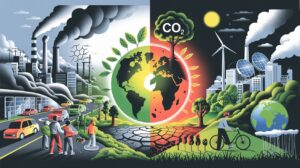Climate change has emerged as one of the most pressing challenges of our time. As global temperatures continue to rise due to human activities, the effects of climate change are becoming increasingly apparent. In this blog post, we will delve into the main threats posed by climate change and explore how they impact our planet and its inhabitants.
Table of Contents
ToggleUnravelling the Main Threats of Climate Change: A Comprehensive Look
Here are some main threats of climate change: How is climate change affecting people?
1. Extreme Weather Events: Intensifying and Unpredictable
One of the most immediate and visible consequences of climate change is the increase in the frequency and severity of extreme weather events. From devastating hurricanes and typhoons to prolonged droughts and deadly heatwaves, these events wreak havoc on communities worldwide. The destruction caused by extreme weather events leads to loss of life, property damage, and economic instability. Vulnerable populations, particularly in developing countries, bear the brunt of these disasters.
2. Sea-Level Rise: The Encroaching Threat to Coastal Communities
As polar ice caps and glaciers melt at an accelerating pace, sea levels continue to rise. This poses a significant threat to low-lying coastal areas and islands, home to millions of people. Rising sea levels can result in increased flooding, saltwater intrusion into freshwater resources, and loss of habitat for both humans and wildlife. Displacement due to sea-level rise is expected to become a significant challenge in the coming decades.
3. Food Security: A Global Challenge in a Changing Climate
Climate change has far-reaching implications for global food security. Shifts in temperature and precipitation patterns, along with more frequent and severe droughts, can negatively impact agriculture by reducing crop yields and increasing the prevalence of pests and diseases. This can lead to increased food prices and decreased food availability, particularly affecting vulnerable populations in developing countries.
4. Water Scarcity: A Precious Resource Under Threat
Changes in precipitation patterns and increased evaporation rates due to higher temperatures can exacerbate water scarcity issues in already water-stressed regions. As freshwater resources dwindle, agriculture, industry, and domestic water supply are all affected, with the potential to spark conflicts over water resources.
5. Health Impacts: Climate Change’s Direct and Indirect Toll on Human Health
Climate change affects human health in both direct and indirect ways. Direct health impacts include heat-related illnesses and deaths caused by heat waves. Indirect health impacts involve the spread of vector-borne diseases, such as malaria and dengue fever, as warmer temperatures facilitate the expansion of disease-carrying organisms’ habitats. Additionally, climate change can worsen air pollution, which has been linked to respiratory and cardiovascular diseases.
6. Biodiversity Loss: Disrupted Ecosystems and Cascading Effects
Climate change contributes to the loss of biodiversity by altering habitats, forcing species to either migrate, adapt, or face extinction. This disruption of ecosystems has cascading effects, such as reduced pollination and pest control services, which can impact agriculture and human well-being.
7. Economic Impacts: The Unequal Burden of Climate Change
The economic impacts of climate change are far-reaching and often disproportionately affect developing countries and vulnerable communities. Damage to infrastructure, disruptions to supply chains, reduced labour productivity, and increased health costs are just a few ways that climate change can destabilize the global economy.
What are solutions to climate change?
Some solutions to climate change include:
- Reducing greenhouse gas emissions by transitioning to renewable energy sources like solar, wind, and hydroelectric power.
- Increasing energy efficiency in buildings, transportation, and industrial processes.
- Reforestation and afforestation efforts to absorb carbon dioxide from the atmosphere.
- Adopting sustainable agriculture practices, such as no-till farming, crop rotation, and agroforestry.
- Encouraging a shift toward plant-based diets to reduce emissions from livestock production.
- Implementing carbon pricing mechanisms, such as carbon taxes or cap-and-trade systems, to incentivize emission reductions.
- Investing in research and development of new technologies for carbon capture and storage.
- Promoting public transportation, cycling, and walking to reduce emissions from the transportation sector.
- Supporting adaptation measures, such as building resilient infrastructure and protecting coastal areas from sea-level rise.
- Raising awareness and encouraging individual actions to reduce energy consumption and carbon footprints.
Related Article: What is the evidence of climate change?
Conclusion: The Need for Urgent Action
The threats posed by climate change are complex and interconnected and demand urgent action. Reducing greenhouse gas emissions, promoting sustainable development, and increasing resilience to climate change’s impacts are critical steps toward a more sustainable future. By understanding and addressing these threats, we can work together to protect our planet and ensure a better quality of life for future generations







2 thoughts on “What Are The Main Threats of Climate Change?”
Pingback: Petersberg Climate Dialogue 2023: Trust & Climate Action
Pingback: Petersberg Climate Dialogue 2023: Trust & Climate Action